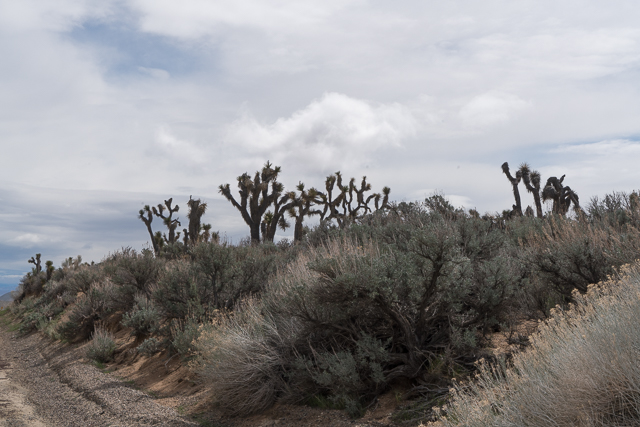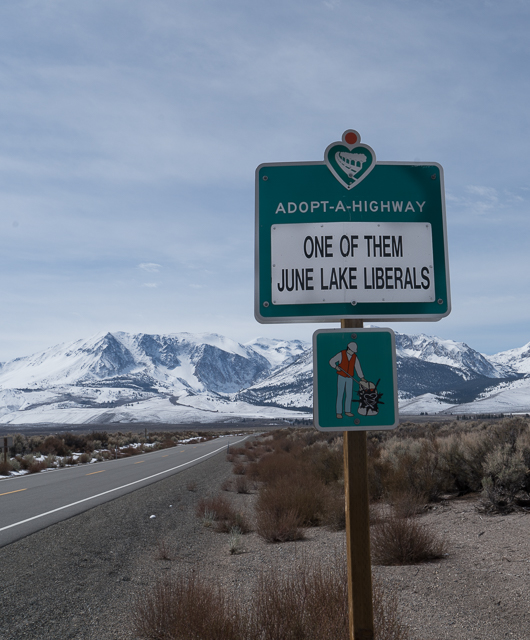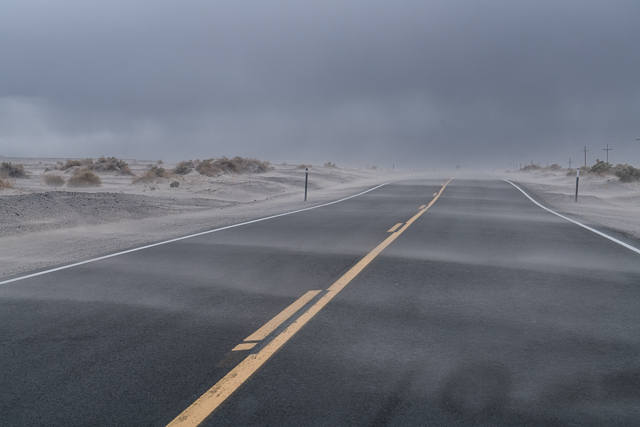
Word had gotten out about the Super Bloom. It had rained an unexpected amount in Death Valley, and the flowers were out, all the flowers, and the valley floor was spectacular. Oh boy, we said, and made plans.
All of the motels in Death Valley were booked (word about the Bloom had spread quickly), so we had to go further afield. We saw some stuff and did some stuff, but it was all just a warm-up for the Bloom. We’d seen a total eclipse of the sun; now we were doubling down. The desert comes alive! Nature fecund and profligate! I’ll do that.
————-
As you drive down I-5 (or up 99), the signs proliferate. “Food goes where water flows,” “Is growing food wasting water?” “Over 1.2 million California jobs depend on agriculture,” “No water no jobs” and, even more succinctly, “Pray for rain”.
(Let me mention the least appealing advertising slogan I have ever encountered, on a billboard for a furniture store north of Fresno: “Come see our stool samples”).

There was a lot of rain on our way down, but all Californians knew that El Nino is a chimera. It seems like a lot of rain, but Lake Isabella, east of Bakersfield, still looked like a large puddle surrounded by barren mudflats. There was a lot of rain in the desert too, hence the Bloom, and there’d been flash floods in places, but the land was still dry and unforgiving
Death Valley was not the site of a famous scene of starvation or disease; there was no mass die-off on the valley floor. It is said that the name came from a careless remark by a young boy attached to the first party of settlers who came through those parts — they were lost, of course.
They came to the lip of the Valley after months of traveling through unknown territory. The first words spoken on that promontory are not known, but I assume they were something like, “Holy Christ, are we ever screwed.”
—————————-
I went into a convenience store search for Chapstick. The girl at the counter waved her hand. I saw an imposing rack of tubes, way more lip ointment than I would have ever thought possible. Aloha Coconut, Mango Sunrise, Cake Batter. The clerk said, “it’s the owner. She’s the queen of Chapstick.”
——————————
The weather was changeable. We drove through rain in the Kern River Valley, through falling snow on our way to Benton, through a pretty good sandstorm on our way to Olancha. The extremes are part of the point; there’s nothing like watching a desert lightning storm sweeping down from the horizon. Big skies create a grander scale; even a contrail can look apocalyptic.

——————————
We had a good soundtrack in the car, everything from Washboard Sam to you-know-who. Nice to roll along the two-lane with old friends.
———————-
We found Benton Hot Springs, which is absolutely in the middle of nowhere. It’s a geothermal oasis, no doubt a great comfort to travelers finding themselves in, well , the middle of nowhere. The hot springs are fresh, and they don’t smell of sulfur; the breakfasts are large and tasty; the innkeepers are young and friendly; and a cat named Sylvester may spend the night with you if you play your cards right.
There are hot springs all over the Great Basin; it’s just that this one has soft beds and heated floors. Bonus: Never any water shortage.
———————————
It’s impossible not to think about water when you’re in the California desert. Take a little apolitical trip to Mono Lake, admire the tufa, and get caught up in one of the great battles of the 20th Century: Los Angeles (very big town) versus the Owens Valley (small and not politically connected). Result: Los Angeles stole water for decades against fierce local opposition. Owens Valley finally won the war, but Mono Lake had dropped 45 vertical feet, lost half its volume, and doubled in salinity.
The famous tufa at Mono Lake (otherworldly towers of calcium carbonate) have been around for a while, but they’ve been much more exposed recently; their appearance is a symptom of the lake’s destruction. Mono Lake owes its salvation to sundry environmental groups, so maybe cynicism is not appropriate in all situations.

——————————–
We got to Death Valley and heard the bad news: The Super Bloom was over. The rain and wind of the previous weekend had beaten down the blooms. We mustn’t expect anything spectacular. Flowers, sure, but we should have been there last week.
We are adaptable travelers; we can make do. We search the hillside for flowers and found a bounty of species. Let me just type their names because I love to hear them: desert star, desert gold, desert trumpet, desert sage, desert five-spot, turtleback, panamint daisy, gravel ghost, fremont phacelia, shredding evening primrose, tufted evening primrose, brown-eyed evening primrose.
I love the idea of the little seeds sitting underground, whistling thinly through their lips and trying to get some sleep. Year after year, nothing happens. All of a sudden, water! Time to push through the soil. Time to make others of your kind. Time to spread your array for an awe-struck world.
I’ve been coming to the desert all my life. My father lived in Pear Blossom for a while, and I visited in the summer. The nearest house was half a mile away; I used to run with the two dogs among the mesquite and the creosote bushes. Later on, Tracy and I would visit Joshua Tree in the spring, and the desert turned romantic. The mountains silhouetted against a red sky; coyotes beginning to howl; the botanical perfume in the morning almost strong enough to wake you up.
I always forget how spacious the desert is, how accommodating. If you live there, you can be anyone you want. Beyond civilization, back in the harsh wilderness, undefined and undefinable; people live for that.
Now I only visit in the spring or fall. If it got to be 134 degrees, as it did in Death Valley once, I imagine I’d be clinging to the air conditioner and begging for mercy.
Of course, it’s a dry heat.
———————————-
We stayed in a town called Shoshone. To check into the $60 motel, we had to fill out a three-page form, initialing promises not to smoke, not to bring a pet into the room, not to run in the pool area. I said, making a joke, “this is like applying for a passport.”
“Yes it is,” said the woman behind the counter, giving me a level stare. “yes it is.”
———————–
The last day we were there, we drove down south of Badwater, because someone said there might be flowers down there. For many miles, only a smattering of flowers. Then we turned a corner and saw it, a field of gold. It was everywhere, climbing up the hillsides, swaying slightly in the wind. Desert golds, mostly, but also a lot of other stuff.
I have no idea whether this was the Super Bloom or not. Let’s just call it the Very Good Bloom. It was, you know, magical.


I wonder if your passport comment was construed as “I’m not from around here, and maybe, just maybe, in this Hello Kitty carryon I am carrying WMDs.” Wouldn’t surprise me.
LikeLike
Lovely! I laughed out loud at “Of course, it’s a dry heat.” We (Californians)always say that, don’t we? I never appreciated the sentiment until I experienced my first un-dry heat, as an adult, and then I knew.
LikeLiked by 1 person
Oh God, humidity. Don’t remind me.
LikeLike
Jon – of the first white settlers to see Death Valley, in the winter of 1849, only one died in the valley, true. But a dozen others died in the hills just to the west while struggling to get out. They were part of a 107-wagon train led by Capt. Hunt out of Utah. They were taking a known trail south to the Old Spanish Trail into So CA, which was also known. 20 of those wagons split off to follow a map of a “sneaker” route supposedly drawn by Walkara, a Ute horse-thief who had raided CA ranchos many times. The 20 wagons bogged down on the Death Valley floor. They burnt their wagons, used the fire to jerk the meat on what was left of their oxen, then tried to make their escape… with the results described. – Paul McH
LikeLike
Good to know. Thanks.
LikeLike
Cats and deserts – oh my! Jon, you have the unerring ability to write columns which, from just a knee-jerk reaction, make me begin to sneeze. Cat dander – where’s my antihistamine? Some kind of pollen produced by all those flowers with wonderful sounding names – here comes the hay fever. Then I meditate on the pleasures of Sea Ranch or Mendocino and feel the allergen-free air easing my symptoms. Funny, the little tricks the mind can play on itself.
LikeLike
Though I loved your column in the Chron, I may love this bog even more. For one thing you can choose to write short or long as you deem fit, for another it has glorious photographs (I meant “snapshots”) by Tracy, and third, it’s free. What a deal!
LikeLiked by 2 people
We like to think so,
LikeLike
What Judith Rascoe said, and the meandering style in this post is about perfect for the content.
LikeLiked by 1 person
Darn, you found Benton Hot Springs and told everyone about it. It one of our favorite places. They may have lots of water but when they water the lawn (they can have lawns) the water must be sprayed in the air to cool it so as not burn the grass.
Love your writing. Keep it coming.
LikeLike
Nice column about some of the most beautiful places there are! A small comments about the tufa. Walter Van Tilburg Clark’s novel The City of Trembling Leaves has one of the characters, an artist, based on real-life Nevada artist Robert Cole Caples, making sculptures from Mono Lake tufa in the ’30s. And Mark Twain mentions the tufa formations in Roughing It, from much longer before that. So, while the water level *is* drastically lowered since 1941, nevertheless the tufa was partially exposed quite a long time ago, long before the water was being diverted to Southern California. A depth chart on the page http://archive.fossweb.com/CA/modules3-6/Environments/activities/mono/content_old.html shows that in the ’30s and in the 1800s the water level was lower than the 1941 level from which the modern drop is measured.
LikeLike
Oops. My bad. I thought…oh never mind. I’ll fix it.
LikeLike
I loved thus. You write about nature so appealingly. Thank you, Kathy
Sent from my iPad
>
LikeLike
Great blog. A meandering blog about your meandering trip. Beautiful balance.
LikeLike
Always nice to hear about the California Desert. I was always fond of Tecopa Hot Springs and Amargosa Opera House. (Apparently Marta Becket is no longer performing, though she’s only 91.)
One winter I arrived at Death Valley just after it had had considerable rain. The Devil’s Golf Course had all dissolved into an extremely shallow lake, waiting for drier days to re-create its formations.
Thanks for continuing to share with us.
LikeLike
Marta Becket’s legacy is being continued by Jenna McClintock, formerly of Oakland Ballet, who was inspired to become a ballerina by seeing Becket perform at the Amargosa when Jenna was a child. (http://www.pe.com/articles/becket-765336-mcclintock-stage.html)
LikeLiked by 1 person
Passed the opera house four times, but it was always closed. Surrealistic place, though.
LikeLike
Great column – I imagine you’ve already read Edward Abbey’s musings – “Desert Solitare” ?…
LikeLike
Jackson Bentley: What is it, Major Lawrence, that attracts you personally to the desert?
T.E. Lawrence: It’s clean.
LikeLike
Love reading your new blog, Jon. Two minor corrections:
The record high for Death Valley is 134, not 143.
Mono Lake is not in the Owens Valley. According to Wikipedia, the Owens Valley is bounded on the north by the Chalfont Valley.
LikeLike
P.S. That should be Chalfant, not Chalfont.
LikeLike
Yes yes on the temp; thanks. For the other, let me poke around.
LikeLike
This adds one more wish to add to my list of things I wish I had done, and places I wish I’d seen, years ago. Nice article, no politics.THanks, Carol Rose
LikeLike
Last fall on my way south I got off 5 due to road work and took a parallel road about 10 miles west. First it went through lush nut orchards, then by a huge nut processing plant. After passing the James Dean Memorial Last Stop center, i drove through many miles of oil fields. Fracking I presume . There was much water usage out of view of the freeway and road signs. Plus the cattle fattening yards use more water than the plant fields.
Love the blog, John.
LikeLike
Hi Jon Carroll, more good people being positive in our discontent! FYI. Carol Rose
LikeLike